


The Mathatron is the first programmable electronic calculator that could fit on a desk and be easily used by an individual. Earlier "electronic calculators" were really mainframe computers that took up a large amount of space and weren't user-friendly. The Mathatron was a ground-breaking machine, since it could be easily used by a person for regular calculations as well as being able to be keystroke-programmed to solve repetitive problems. One could say that the Mathatron might possibly be the first device that could be called a "desktop computer" or "personal computer". It is clear that the Mathatron is the first device that fits the description of programmable electronic calculator. Other desktop electronic calculators that came out slightly ahead of the Mathatron, such as the Friden EC-130 and the Sharp CS-10, did not include programming capability. The Mathatron was also ground-breaking in that it was the first electronic calculator that used true algebraic logic to evaluate mathematical expressions, with parenthesis capability being included.
This machine was the brainchild of three men: William Kahn, Roy Reach, and David Shapiro, who worked on the design of the machine in the early 1960s in Waltham, Massachusetts. The name "Mathatron" was coined my Mr. Reach's wife, Margaret. The inventors would go on to obtain a patent on the design of the Mathatron's algebraic logic system. Interestingly, this patent would later be bought by the Hewlett-Packard company, which is thought of more for their Reverse-Polish-Notation (RPN) logic system.
The photo below is of a Mathatron model 8-48. It is an extremely large and heavy desktop calculator, indicative of the technology available at the time it was developed and manufactured.

The Calculator Museum has two Mathatron units, one a model 4-24, serial number 00133, and the other is the model 8-48, with a serial number of 05110. The date codes on these units indicate that these were likely built in the 1964-1965 timeframe. The Mathatron calculator was first announced to the world in November, 1963, and was in production in 1964, a year prior to the first desktop minicomputer - the DEC PDP-8. The Mathatron family was also expandable, according to advertisements that ran heavily in national magazines during 1966 and 1967. Additional program steps, data registers, and "Optional Prewired programs for special applications" could be added, up to eleven were available (it is not known if more than one could be added to the machine at a time). Also optional were a paper tape reader/punch and a page printer. One advertisement for the Mathatron that ran in the fall of 1966 said that "More than 80% of Mathatron owners have access to a big computer, but they would rather get quick answers than fight that battle," indicating that the company had a significant installed base in 1966. The base price of the Mathatron in 1966 was listed at $5,000. The Mathatron family apparently went through some upgrades, as the model shown in the 1966 advertisement is a more advanced scientific unit with additional keys to perform log, trig, and power functions. The Mathatron was manufactured by the "Mathatronics Company" in Massachusetts (the company started by the three inventors), which was purchased and became a division of the Barry Wright Corporation in 1966. The Barry Wright Corporation is still in business today and is known as "Wright Line".
The Mathatron calculator measures 24" on a side, and is 14" tall along the rear cover of the machine. It weighs over 80 pounds. Power consumption is listed at 200 Watts.
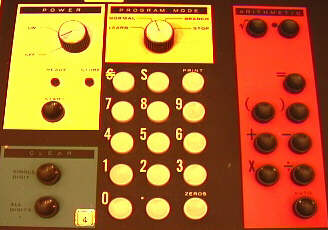
As shown in the above photo of the Mathatron's keyboard, it is a fairly basic calculator with four functions and square root. The arithmetic operation keys are located in the red section on the right hand side of the keyboard. The Mathatron is perhaps the first machine that also has parenthesis keys, and one of it's highly touted capabilities was the ability to accept equations directly as keyed in. The unit also supported scientific notation, with the * key used to enter the power-of-ten exponent for a number.
The Mathatron was capable of nine-digit accuracy for the maintissa portion of a number. It apparently used only two 4-bit words for the exponent part, as the range for the exponent part was listed from 10^-42 to 10^+58. I would guess that the machine used 45 bits for each number stored, 36 for maintissa, one for sign, and eight for exponent. The speed of the unit is listed at "100 accumulations per second."
The Mathatron also has both program memory and data memory. The programming capability is controlled by a four-position rotary knob above the number-entry keys. The four positions are: LEARN, NORMAL, BRANCH, and STOP. I have no information at this point on how the programming functions are used. Data memory is controlled by the three white keys at the top of the number-entry area. The leftmost key is an S with an equals sign through it, which possibly stores the result of a calculation in a memory register. The "S" key is the Store memory key, and is followed by a single-digit number indicating the register to store the current number entry into. The PRINT key is used to print out/recall the contents of a memory register, and is followed by a single-digit number indicating the register to recall. The STORE light to the left of the "=S" key indicates that a memory operation is pending (and the machine is awaiting the key entry to indicate the register number for the operation).
The number of registers and program steps that the unit supports, is embedded in the model number. The model 4-24 has four memory registers and is capable of storing 24 program steps, and the model 8-48 has eight memory registers and is capable of storing 48 program steps. The advertisement from 1966 lists the memory capabilities as follows: Program memory (core), 24 to 480 steps; Addressable storage, 4 to 88 registers, across the line of machines that were manufactured.
Control of the unit is by the power ON/OFF rotary knob in the upper left of the keyboard. There is a READY lamp underneath that indicates the machine is ready for calculations. Underneath is the START button which appears to be for master clear/reset. In the blue area in the lower left corner are two clear keys, the top one is used for clearing the last digit entered and the bottom one is for clearing all digits.
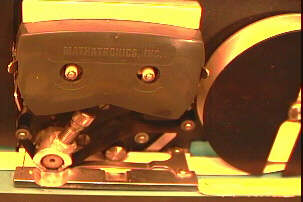
Output for the Mathatron is via a "ticker-tape" style printer, as shown in the above photo. The paper tape is approximately 1/2" wide and is fed from a spool on the left. This feeds into the print mechanism, where the ribbon feeds from the cartridge above the mechanism on top of the paper, underneath a small wheel. This wheel has the numbers embossed on it, which turns to the appropriate digit to print, and there is a solenoid that strikes a plate underneath the paper. This forces the paper to press against the ribbon and the print wheel, leaving ink behind on the paper to form the desired digit. Another motor then drives a small rubber roller to move the paper slightly to the left. The machine continues to print one digit at a time until the number is printed. When number or operation keys are being entered, the printer prints each digit or operation symbol as the key is pressed.
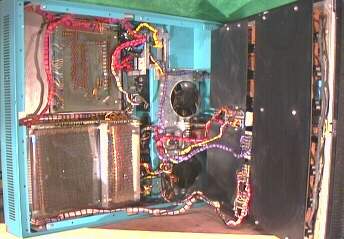
In the above photo, the unit is laying on it's left side, with the main section on the right and the logic unit on the left. The logic unit printed-circuit boards are covered by protective sheets of heavy plastic. The keyboard encoder PCB is in the upper left corner of the main unit. Below is the core memory module, covered with a clear sheet of plastic material. This core memory module has the full expansion installed. In the middle of the photo are the connectorized cable assemblies that connect the logic unit to the main unit. There are five "block" type connectors, each with approximately 24 pins for the interconnect between the main unit and logic unit. It is difficult to see in the photo, but the keyboard unit is also connectorized and can be detached from the main unit.
The Model 8-48 apparently has some additional features that were not included in the Model 4-24. There are several extra connectors that provide a "bypass" expansion capability - the keyboard connectors do not plug directly into the logic unit, they go to a series of connectors on the main unit itself and another set of cables is provided from there to the logic unit. On the Model 4-24, everything goes directly from the main unit to the logic unit. The Model 8-48 also has some peripheral I/O connectors on the bottom of the unit, and I suspect that the additional "bypass" connectors on the main unit are to allow the peripherals to be attached to the unit. This is likely where the paper tape reader/punch and the page printer options were connected to the unit.
The Mathatron uses transistor technology along with a large number of hybrid circuits. The hybrid circuits are unusual in that they are two-sided, with leads coming out both the top and bottom. The bottom leads are soldered into a single- sided fiberglass printed-circuit-board (PCB), and the top wires extend upwards. Laquer-coated, very small wire is used for point-to-point wiring to connect the top hybrid pins to other hybrids. It appears that there are only a few different hybrid types used in the machine, and selective point-to-point wiring was used to configure the hybrids for the logic needed for the machine. All of the wiring within the logic unit is done this way, and although there are eight individual PCBs in the logic unit, they are permanently wired together. The only connectors are from the logic unit to the main unit. Given the manufacturing technology at the time it makes sense that the logic unit was replaceable, since on-site servicing would be nearly impossible.
When the Mathatron is turned on its side, the bottom cover of the logic unit can be removed, revealing four of the eight logic boards, as shown in the following photo:
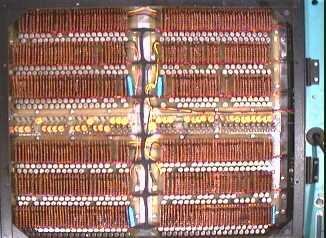
The following photo shows the four logic boards on the inside section of the logic unit, with the protective covers removed. The black rectangular objects are the block connectors for the interconnect with the main unit.

The next photo shows a close-up of one of the eight PCBs in the logic unit. The layout of all the PCBs appears to be nearly identical (if not identical).
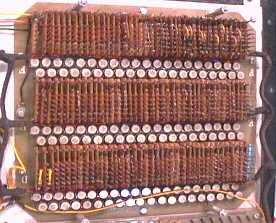
The following photo shows a close up of the transistor and hybrid circuitry for one of the logic unit PCBs.

The Mathatron has a very large power supply, with two muffin fans that blow air across it for cooling. The power supply is located beneath the rear cover of the machine.
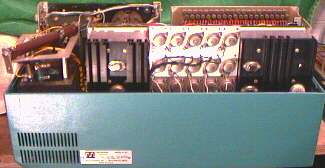
The above photo shows the power supply area with the main cover removed. There is a very large transformer on the left side, with a large wire-wound resistor with a slider mounted above it. There are several other smaller wire-wound resistors with sliders also mounted in a cage nearby. These were probably to set the voltage of the power supply unit. There are quite a few large transistors in the power supply area. In the top right hand part of the picture, the transistors for an add-in circuit board are visible, these are likely for the additional peripheral control that the Model 8-48 contains.
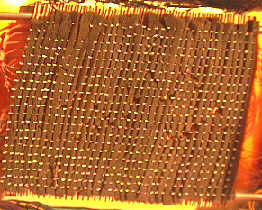
The above photo shows the core memory module for the model 4-24. This appears to be much different than the core memory modules that I have seen in later calculators, such as the Wang 360SE, Sharp Compet 361, and SCM Cogito 616. This core module is very large, and appears to be optimized for use of low-cost manufacturing technology. The memory module in this picture measures approximately eight inches square. The model 8-48 has an additional module that is the same height but about one-third as wide stacked on the right side.
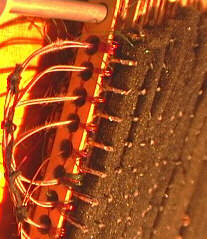
The above photo shows a closeup of the edge of the Mathatron core memory module. It appears that the magnetic cores are embedded in paper, cardboard, or wooden strips that run vertically. There are insulating foam strips inserted between each of the vertical core strips. There are holes at the top and bottom of each strip that each runs through a horizontal metal rod that holds the unit together. The model 4-24 has 37 of the core strips, with each strip containing 20 cores. This would allow the machine to store 740 bits of information. The additional module on the 8-48 contains 12 strips with 20 cores. I could not see behind the additional module to determine if it has more strips than the 4-24 in the main core section. If not, it's storage capacity would store 980 bits.

The Mathatron's keyboard utilizes plastic keycaps that have a plunger on the bottom, held forward by a spring, that presses down the lever of a standard microswitch when the key is pressed. The above image shows a close up of the back side of the Mathatron's keyboard.
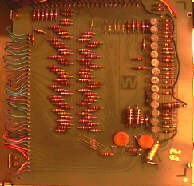
The outputs of the microswitches are wired over to the single-sided PCB, shown above, that contains a number of resistors and transistors, apparently to make a keyboard encoder, to minimize the number of connections between the keyboard and the logic unit.
"Vanquish your problems as they come, with Mathatron, the $5,000 digital computer. No need to go to number-systems school or build a FORTRAN empire. Just express yourself in algebra on the Mathatron keyboard -- use power-of-10 exponents, parentheses, square roots and decimal points.
"Mathatron is a programmable, general purpose, electronic companion that saves hours of a professional man's day. Up to 11 pre-wired programs, expandable memory, optional paper tape reader/punch and page printer.
"More than 80% of Mathatron owners have access to a big computer, but they would rather get quick answers than fight that battle. Write for the whole story.
mathatron: Program memory (core), 24 to 480 steps * Addressable storage, 4 to 88 registers * 9 significant digits, exponent, and sign * Number range ±10(-42) to 10 (+58) * Speed 100 accumulations per second *Optional prewired programs for special applications.
MATHATRONICS
a division of Barry Wright Corporation
You key into MATHATRON like this ( ( 2 - 3 / 6 4 ) / ( 8 X 1 4 . 7 ))^ 1 . 4 1 6 / 3 ) =
And Mathatron prints like this: ((2-3/64)/(8X14.7))**(1.416/3)=.144541421
MATHATRON IS MUCH MORE THAN JUST A CALCULATOR
"Only Mathatron will accept an equation keyed in exactly as you write it, and print it out along with the solution. It is the only machine that understands the rules of algebra and can provide parenthecation along with powers-of-ten exponents, full-floating decimal point and square root.
"Mathatron uses only solid state components and has a core memory for storage of forumlas, numbers, programs or intermediate results. The basic Mathatron is expandable. Additional storage registers, program storage, power log, paper tape punch/reader and page printer can be added.
"Why settle for a calculator when you can have a Mathatron. Send today for illustrated brochure. Wright Line, A Division of Barry Wright Corporation.
MATHATRON
COMPUTER/CALCULATORS.
DATA PROCESSING ACCESSORIES
AND PORTABLE CARD PUNCHES